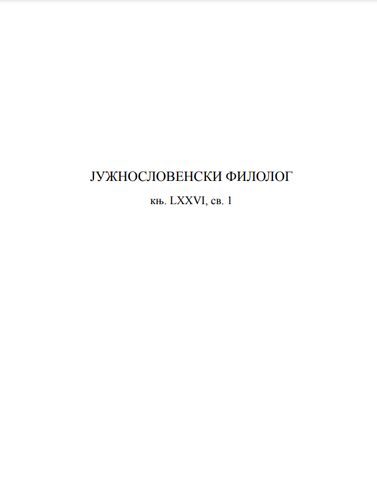ГОВОР ВРАЊА КРОЗ ПРИЗМУ ДИГЛОСИВНОСТИ
VRANJE SPEECH THROUGH THE PRISM OF DIGLOSSIA
Author(s): Tatjana G. Trajković, Milica M. MihajlovićSubject(s): South Slavic Languages
Published by: Институт за српски језик Српске академије наука и уметности
Keywords: Serbian language; urban dialectology; Prizren-Timok dialect area; Prizren-South Morava dialect; Vranje speech; diglossia
Summary/Abstract: The paper presents the results of diglossia research in the speech of Vranje. This is a survey conducted through the poll of two groups of representatives of the Vranje vernacular. Groups of final year high school students from Vranje and teachers teaching in the same schools were selected. In this way, social variables were monitored: origin, age, education and gender. Typical features of Vranje speech were selected from the language variables: consonant dz (dzindza), semi-vowel ǝ (danǝs), vocative in -e (strinke), enclitic pronouns (gu, gi, ne, ni, ve, vi), the analytical declination (s majku mi, s mene, na mene mi vika, davam na njega), present 3rd person plural in -v, present participle, masculine, singular in -ја, future forms without infinitives (će padneš, će dođe), lexeme tatko. The above categories also include additional dialectic features marked by Vranje speech: verb forms in -nа-, possessive dative, object reduplication, express analyticism in declination, analyticism in conjugation. The aim of the research is to determine whether diglossive behavior is intrinsic to native Vranje speakers and how code switching occurs in certain speech situations. Speakers’ attitudes toward dialect use were also examined. The conclusion is that male speakers of both ages and education levels are mostly interested in maintaining the dialect. The smallest number of speakers who are in the care of the dialect and use the dialect in everyday conversation is in the group of highly educated women. The majority of interviewed Vranjanians are aware of their ability to control speech, which means that they are prone to diglossive behavior. Qualitative and quantitative analysis of the data collected revealed that young male Vranjanian people are most attached to the dialect, and that women of higher education use dialectal elements in speech in the least. The dialectal lines that are most amenable to adaptation could be presented in the order of susceptibility levels: consonant dz, semi-vowel ǝ, vocative in -e, present 3rd person plural in -v, -ја form, enclitic gu, enclitic gi, enclitics ne, ni, ve, vi, lexis, the analytical declination, infinitives. Such an analysis of the selection of dialect features in order to adapt to the standard also points to the possible internal development of the dialect itself. This would mean that the most subtle lines would gradually disappear from the dialectal structure. It is uncertain whether they will be completely lost and when such changes will occur.
Journal: Јужнословенски филолог
- Issue Year: 76/2020
- Issue No: 1
- Page Range: 77-105
- Page Count: 29
- Language: Serbian

